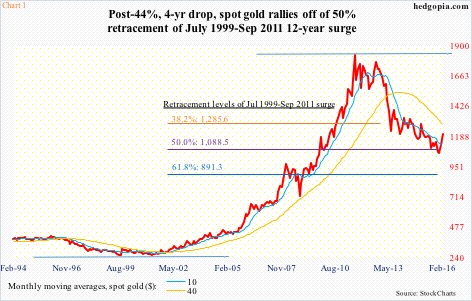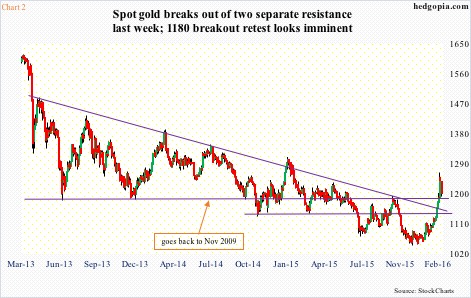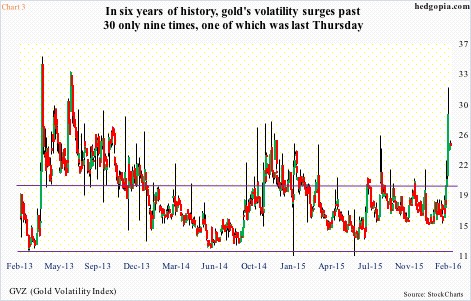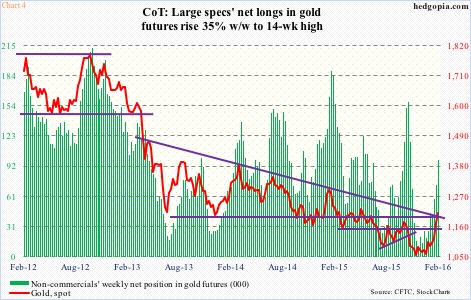Gold bugs may need to step up to the plate.
Off the December 3rd intra-day low of $1045.4 through February 11th spike high of $1263.9, spot gold surged 21 percent in just over two months. Not bad for an asset that shed just under 46 percent since peaking in September 2011 through that December 3rd low.
That low has potential to be an important low.
In July 1999, gold bottomed at $253.2 before getting on a 12-year bull run in which the metal surged 7.6x before peaking in September 2011 at $1923.7. A 50-percent retracement of that surge puts the spot at $1088.45, which is not that far away from the December 3rd low (Chart 1).
Come February, gold began to build on the basing action underway since December. Not only did it hurriedly take out the 200-day moving average but also $1180. Going all the way back to November 2009, bulls and bears have time and again dueled over this price point.
The problem in all this was that by the time the breakout took place, gold was pushed into deep overbought conditions. The daily RSI registered 88 on February 11th.
Similarly, a 38.2-percent Fibonacci retracement of the September 2011-December 2015 drop lies at $1214. The spot spiked to $1263.9 on February 11th. That more than retraced 38.2 percent of that four-year decline, but fell short of retracing 50 percent ($1317).
A pullback is perfectly normal under these circumstances. It is a normal pullback if there is enough buying interest when a breakout retest occurs. The metal is fast approaching that level, and it has not even unwound its daily overbought conditions, not to mention weekly.
In the event that gold loses $1180, support at $1140 once again comes into focus, which also approximates the 200-day moving average ($1132). This would also test the trend line breakout (Chart 2). All in all, a must-hold.
Here is what gold bugs would not want to see.
In its brief history of nearly six years, GVZ, the gold volatility index, has surged past 30 only nine times, one of which was last week; on February 11th, it spiked to 31.60. The all-time high of 43.51 was recorded in September 2011, when the metal peaked. In hindsight, these north-of-30 spikes have been a good time to sell volatility/spot.
Looking at the far right of Chart 3, it does look like volatility is itching to go lower from here. GVZ’s daily chart in particular is way overbought.
In this scenario, gold bugs would be hard pressed to defend $1180, and $1140 after that.
As in the past, one group of traders that bear close watching are non-commercials, who until last Tuesday continued to add to net longs in gold futures – to a 14-week high (Chart 4). This was before the 4.1-percent spike in the spot last Thursday, so that session may have changed the supply-demand dynamics.
Thus far, gold bugs have the backing of these traders, and will need their support going forward in order to defend $1180 at best and $1140 at worst.
Thanks for reading!

